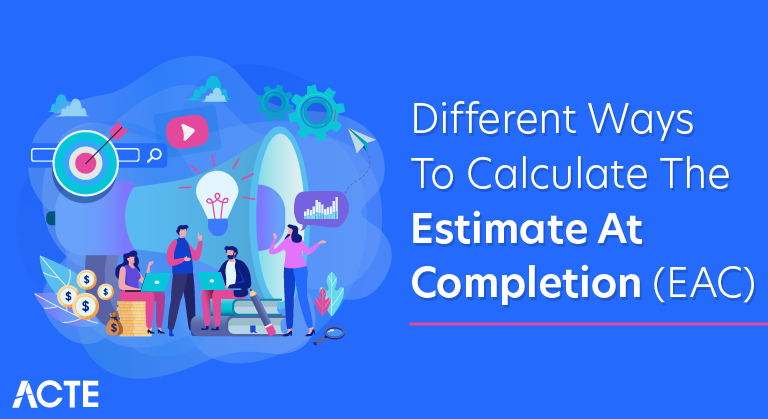
What is Estimate at Completion (EAC)?
- According to the PMBOK Guide, Estimate at Completion is “The expected total cost of completing all work expressed as the sum of the actual cost to date and the estimate to complete.”
- Just in case the definition above doesn’t give you a complete picture, let me give you a simple example.
- Let’s say you are somewhere in your project. The client comes and asks you how much they have to spend to complete the project and your project has deviated from the cost baseline.
- Therefore, you will estimate the new budget and give this number to the client. This is the Estimate at Completion (EAC). Estimate at Completion allows the project manager to see the final project cost estimate.
- Project work does not always go as planned. There are many circumstances beyond your control that may require a change in your plan. Funding requirements keep on changing from the moment the project starts.
- It is your responsibility as a project manager to influence the factors that cause changes. However, if alterations occur, you have to manage them.
Estimate at Completion
Estimate at completion (EAC) is a forecasting technique employed to estimate the cost of a project at completion. Calculating estimate at completion helps measure how much a project may be off-track and can help inform the most appropriate corrective changes to make. There are four ways in which estimate at completion can be calculated. Each formula is used for a specific scenario and considers different factors.
Formula One
When the future financial performance of a project is expected to be similar to the past performance, estimate at completion can be calculated using cost performance index. Cost performance index (CPI) indicates how a project is performing with regards to cost. CPI is calculated as earned value divided by actual cost. Earned value (EV) is the estimated cost at a specific stage in the project, and the actual cost (AC) denotes the actual expenditure of the project at that stage. The formula for CPI is as follows:
- Cost performance index (CPI) = Earned value (EV) / Actual cost (AC)
If the earned value is equal to the actual cost then the CPI would be equal to 1, which denotes that the project is on track. Budget at completion (BAC) is the original total budget estimate created at the beginning of a project. Formula 1 assumes that the future financial performance of the project will be the same as the past performance of the project. Estimate at completion (EAC) is calculated as budget at completion divided by cost performance index. Formula 1 for EAC is as follows:
- Estimate at completion (EAC) = Budget at completion (BAC) / Cost performance index (CPI)
For example, Project A has an estimated budget at completion of $100,000 and a cost performance index of 0.8. The project manager believes that the past performance of the project will mirror the future performance.
- Estimate at completion (EAC) = Budget at completion (BAC) / Cost performance index (CPI)
- Estimate at completion (EAC) = $100,000 / 0.8 = $125,000
Therefore, the estimate at completion would be $125,000.
Formula Two
If the project went off-track due to a specific aspect then we can use formula 2. This formula calculates the EAC by adding the actual cost to the difference between budget at completion and earned value. Formula 2 assumes that the rest of the project will proceed as planned. Formula 2 for EAC is as follows:
- Estimate at completion (EAC) = Actual cost (AC) + (Budget at completion (BAC) – Earned value (EV))
For example, Project B went off-track on one specific task. Project Y has a budget at completion of $100,000, an earned value of $30,000, and an actual cost of $35,000. The rest of the tasks are expected to be on track with the original budget.
- Estimate at completion (EAC) = Actual cost (AC) + (Budget at completion (BAC) – Earned value (EV))
- Estimate at completion (EAC) = $35,000 + ($100,000 – $30,000) = $105,000
Therefore, the estimate at completion would be $105,000.
There are four ways to calculate EAC based on how you expect the future of the performance of the project to be:
He budgeted cost Future performance will be based on past actual performance If you think the existing variance was a unique event and the rest of the project is likely go according to plan, simply add the remaining project budget to the actual cost incurred to date (AC). This method does not assume the project finishes on budget. Rather it takes into account the one time event and adjusts the remaining project plan upward or downward accordingly.EAC = AC + (BAC – EV)
- Future cost performance will be based on past cost performanceIf you think the past performance is not unusual and the past performance is a good indicator of the future, you would use this formula.EAC = AC + [(BAC – EV) / CPI]
- Future cost performance will be influenced by past schedule performanceSince schedule and cost performance are usually related, there could be a reason to adjust the cost performance based on the schedule performance. For example let’s say the CPI (cost efficiency) is very low but SPI (schedule efficiency) is high, you would be justified in thinking that the final cost performance won’t likely be as bad as the CPI would suggest. In the following formula an average of the CPI and SPI are used to extrapolate the final project cost.EAC = AC + [(BAC -EV) / (CPI x SPI)]You could also use a combination of the SPI and CPI instead of a straight average. In the formula below, 20% of the SPI and 80% of the CPI has been used to determine the final project cost.EAC = AC + [(BAC -EV) / (0.8·CPI x 0.2·SPI)]
- A new estimate is producedIn this case a Management ETC can be added to the to-date cost (AC) to determine the final EAC.EAC = AC + ETC
The first two forecasting methods represent the high and low extremes, and the third represents an attempt to forecast somewhere in between those extremes. Finally, the fourth method represents a new estimate, a brand new value taken from other sources if none of the other methods are able to produce the desired result.
For example, if the project is currently over budget, the worst case scenario would have you forecasting using the current trajectory. The best case scenario would have you using the original planned trajectory, starting from today’s date. If you feel you need to be somewhere in between, you can use a combination of the past schedule and cost performance (SPI and CPI), and if none of those alternatives give you the desired result, you will need to produce a new estimate.
EAC Example
In this example we will predict that the current problems were caused by a one time event that isn’t likely to repeat itself. Thus, the EAC will use formula #1.
EAC = AC + (BAC – EV)
EAC = $4,000 + ($10,000 – $2,000) = $12,000.





